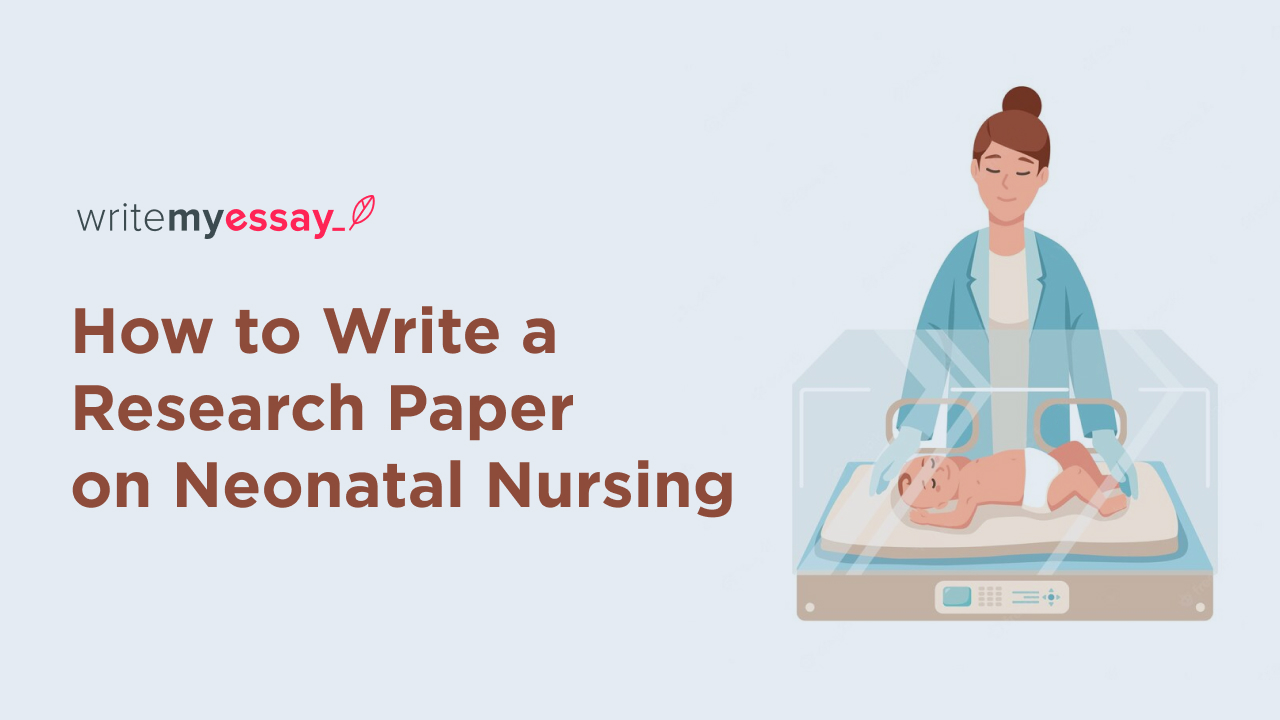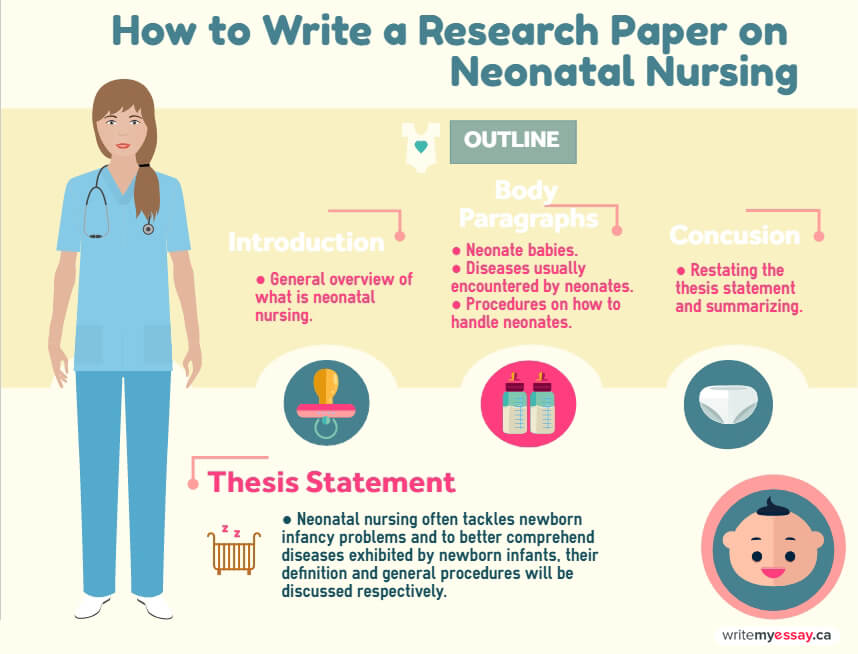
How to Write a Research Paper on Neonatal Nursing

Table of Contents
Research Paper on Neonatal Nursing
- How to start a research paper on neonatal nursing
- Example of the outline
- How to write the introduction
- How to write the thesis statement
- Example of the thesis statement
- Example of the introduction
- How to write body paragraphs for the research paper on neonatal nursing
- Example of the 1st body paragraph
- Example of the 2nd body paragraph
- Example of the 3rd body paragraph
- How to finish the research paper on neonatal nursing
- Example of the conclusion
- Research paper revision

An essay is and will always be a part of a student’s course curriculum, from learning how to write basic works to the preparation of essays needed for a job application, be it a writer or even as a medical professional. Essays are also vast in the range of topics they talk about. One such topic is “neonatal nursing”. As a student of the nursing college, one can be tasked by the professor or the clinical instructor to write about “neonatal nursing” but the student has encountered a problem since the topic needed to be discussed is so vast that narrowing it down would prove to be difficult. To go about it, the student had decided to follow the simple steps on how to write your essay regarding neonatal nursing.
How to start a research paper on neonatal nursing
Before jotting down all the points regarding neonatal nursing, the first thing to consider is conducting preliminary research. As a nursing student, the first priority is to find out what neonatal nursing is and then check some essay samples about the topic. By principle, though the student gets ideas from other peer’s work does not necessarily obligate them to copy essentially but have the papers act as a guide instead.
After reviewing such papers, the student should then list down at LEAST three topics about neonatal nursing they wish to write on. Once they are done, they should now conduct their own research. Since the topic is about neonatal nursing, content that the undergraduate can search for is on the type of patients that neonatal nurses encounter on a regular basis (such as preemies or premature babies), congenital birth defects that nurses need to take into account most, and so much more. Neonatal nursing can also be written in terms of congested steps on standard operating procedures when handling newborn infants, during, and after a one-month incubating period or up until six-months since usually, neonatal nurses tackle patients with severe health conditions. Generally speaking, the undergraduate must take serious consideration on the topics they want to write about since they will also need to do extensive research due to the complexity of the nature of this subject.
Example of the outline
Moving onto this part, you need to consider that your outline should contain only brief information on neonatal nursing. You need to make sure to organize the paper properly by dividing it into three parts: an introduction, body, and conclusion.
I. Introduction
- General overview of what is neonatal nursing.
II. Body paragraphs
- Neonate babies.
- Diseases usually encountered by neonates.
- Procedures on how to handle neonates.
III.CONCLUSION
- The outline plays a critical role as a guide in making sure that the author is able to write in an organized and time-efficient manner. The outline also acts as an early correction for subtopics.
- Initiate with a hook.
- Find relevant information.
- Avoid clichés.
- State the worth of the work.
- Write down the main ideas.
- Jot down supporting points for the main ideas written.
- Elaborate the supporting points. In elaborating the supporting points, make sure to go over the information gathered. Since the topic is about neonatal nursing, it is important to take note that the data gathered must be from reputable sources (such as journals and medical books).
- Include a summary for each of the body paragraphs.
- Go over the body paragraphs once more.
- Restate the thesis statement.
- Be able to summarize all supporting points made.
- Tackle possible future research for the topic.
- Acknowledge limitations.
- Give an interesting final impression of the paper.
- A conclusion also has three to four sentences in order to properly finish the paper.
How to write the introduction
Writing an introduction can be done in various ways but one fact remains the same: it must make the reader continue reading the paper until the end. How would one go about this?
Generally, a hook sentence is something that grabs the reader’s attention immediately. It can range from interesting information, dialogue, anecdote, information summary, and quotes. To give a brief overview, your information is factual data that the writer wants to report on. Your hook can have different forms. It can be a dialogue which is simply a conversation between speakers; an anecdote which is an illustration to get the point across; information summary which is an explanation of the topic discussed, or a quote taken from a famous person, especially concerning the field and with relation to the author’s own main idea.
This is self-explanatory since the entire paper should have connected with each other parts.
Try to avoid cliché statements or statements that the readers already know about.
Explain why the readers should read the paper from start to finish. This can be done through the use of a hook.
How to write the thesis statement
Your thesis statement should be as clear and concise as possible. When writing this part, the author must avoid vague words. You may also use words which specifically points the main idea of their paper.
Example of the thesis statement
Neonatal nursing often tackles newborn infancy problems and to better comprehend diseases exhibited by newborn infants, their definition and general procedures will be discussed respectively.
Example of the introduction
Neonatal nursing is a subspecialty for nurses. This is a program specifically designed for newborns and infants up to one-month-old. Neonatal nursing proves to be an essential part of the infant care team. They are trained to make sure that these newborn and infants are able to survive, whatever health hazard encountered.
How to write body paragraphs for the research paper on neonatal nursing
Body paragraphs, much like the introduction, have some basic principles to follow. So, to complete this task correctly, you need to know some basic rules.
Example of the 1st body paragraph
Neonate babies are delicate babies who can take the turn for the worse in just a matter of seconds. It is important to empathize with these babies as they will also directly affect the parents. As a neonatal nurse, it is important to develop proper social skills when communicating with both the babies and the parents involved.
Example of the 2nd body paragraph
Neonate babies often counter a wide range of diseases. Diseases encountered are usually cardiac malformation, congenital birth defects, infection, and even prematurity. Though neonatal nursing compromises of a one-month span, these are usually extended into months due to the severity of the afflictions experienced by the infants.
Example of the 3rd body paragraph
As a neonatal nurse, it is important to acquire the skills to be able to make a difference in the lives of the infants as well as their families. Important skills that the nurses should take into account is knowing the basics such as skin care or breastfeeding. Other than the skills acquired in handling these babies, it is also important to know how to report their medical reports or to write clinical reports.
How to finish the research paper on neonatal nursing
To finish the research paper, the author must be able to do the following:
Example of the conclusion
Neonatal nurses are considered to be one of essential parts of the neonatal intensive care unit. Neonatal nurses must continue to hone their skills for handling neonates. Though neonatal nurses handle caring for the neonates, there are certain limitations and restrictions to which they cannot do anything about it.
Research paper revision
Since this type of paper is quite specific and may even be a complex type of writing, editing and revisions for grammar and punctuation mistakes are not enough. The author should also give his or her paper on a peer review before submission and then do the final revisions.


